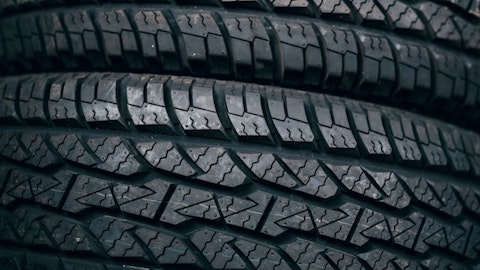Monro, Inc. (NASDAQ:MNRO) Q2 2024 Earnings Call Transcript October 25, 2023
Operator: Good morning, ladies and gentlemen, and welcome to Monro Incorporated Earnings Conference Call for the Second Quarter of Fiscal 2024. At this time, all participants are in a listen-only mode. [Operator Instructions] And as a reminder, this conference call is being recorded and may not be reproduced in whole or in part without permission from the company. I’d now like to introduce Felix Veksler, Senior Director of Investor Relations at Monro. Please go ahead.
Felix Veksler: Thank you. Hello, everyone, and thank you for joining us on this morning’s call. Before we get started, please note that as part of this call, we will be referencing a presentation that is available on the Investors section of our website at corporate.monro.com/investors. If I could draw your attention to the Safe Harbor statement on slide two, I’d like to remind participants that our presentation includes some forward-looking statements about Monro’s future performance. Actual results may differ materially from those suggested by our comments today. The most significant factors that could affect future results are outlined in Monro’s filings with the SEC and in our earnings release. The company disclaims any intention or obligation to update or revise any forward-looking statements, whether as a result of new information, future events or otherwise, except as required by law.
Additionally, on today’s call, management’s statements include a discussion of certain non-GAAP financial measures, which are intended to supplement and not be substitutes for comparable GAAP measures. Reconciliations of such supplemental information to the comparable GAAP measures will be included as part of today’s presentation and in our earnings release. With that, I’d like to turn the call over to Monro’s President and Chief Executive Officer, Michael Broderick.
Michael Broderick: Thank you, Felix, and good morning, everyone. I’d like to spend the first part of our call this morning walking through our second quarter performance, which reflected top line results that were challenged. This was due to consumers deferring tire purchases as persistent inflationary pressures impacted purchases of higher ticket items across the retail spectrum. This was clearly evidenced by an industry-wide slowdown entire unit sales in the regions of the country where a vast majority of our store footprint is concentrated. We mitigated this slowdown with actions to reduce non-productive labor costs, including overtime hours in our stores. Despite a tough macroeconomic environment, the resiliency of our business model allowed us to expand gross margin and maintain our year-over-year profitability even on a lower tire sales volume.
I’ll also discuss our plans to deliver improved earnings this fiscal year despite some of the consumer related headwinds that we and others in our industry are experiencing. Before I get into the specifics, I’d be remiss if I didn’t take a moment to recognize and thank all of our teammates for their continued dedication to Monro, serving the needs of our customers as well as their positive contributions to the communities where we operate. Now turning to our second quarter results. Our second quarter comparable store sales declined approximately 2%. Comp store sales were down approximately 1% in our 300 small or underperforming stores, and down approximately 2% in our remaining store locations. As I stated earlier, our sales results in the quarter were challenged by consumer deferrals of tire purchases as evidenced by industry-wide slowdown entire unit sales in the regions of the country where a vast majority of our store footprint is concentrated.
This led to pressured store traffic, which was not supportive to sales of our higher margin service categories in the quarter. While our tire units were down approximately 10%, leveraging the strength of our manufacturer funded promotions allowed us to optimize our assortment for improved tire profitability in the quarter. And while continued consumer trade-down dynamics led to a higher proportion of lower margin opening price point tires within overall industry unit sales, we remain focused on maintaining a healthy mix of opening price point tires in the quarter. Encouragingly based on the retail sellout data from Torqata, a subsidiary of ATD, we maintained our tire market share in our higher margin tiers. We mitigated this industry-wide slowdown in tires with actions to reduce non-productive labor costs, including overtime hours in our stores, which were down 26% year-over-year and 14% sequentially.
This allowed us to expand gross margin and maintain our year-over-year profitability even on lower tire sales volumes. We will continue to closely manage our labor costs and expenses to maximize profitability, now concluding with our plans to deliver improved earnings this fiscal year despite a choppy consumer environment. While our preliminary comp store sales for fiscal October are down approximately 5%, our stores are properly staffed and ready for the back half of the year. And while we will need to see an improvement in the overall health of the consumer before we can fully capitalize on longer term industry tailwinds, we have successfully repositioned our cost structure to deliver improved profitability even on lower comp store sales.
We will remain relentlessly focused on achieving comp store sales growth through accelerating growth in our 300 small or underperforming stores, maintaining a balanced approach between our tire and service categories with competitive pricing to drive store traffic and continuously improving our customer experience. We’ll also strive to expand our gross margins through properly training our teammates to maximize their productivity. However, given the current pressures on the consumer, we are also laser-focused on maximizing profitability through prudent cost control, which concludes right sizing our fixed costs and rationalizing unproductive labor. While we take these actions, we will not cut productive labor at the sacrifice of our standards and to the detriment of our long-term service model.

In addition, we will continue to create cash by optimizing inventory and leveraging the strength of our vendor partners for better availability, quality and cost of parts and tires in our stores. In closing, despite the challenges posed by the current macroeconomic environment, our business continues to be well-positioned and we are confident that we remain on a path to restore our gross margins back to pre-COVID levels with double-digit operating margins over the longer term. With that, I’ll now turn the call over to Brian, who will provide an overview of Monro’s second quarter performance, strong financial position, and additional color regarding fiscal 2024. Brian?
Brian D’Ambrosia: Thank you, Mike and good morning, everyone. Turning to slide eight, sales decrease 2.3% year-over-year to $322.1 million in the second quarter, which was primarily due to lower tire unit sales. Comparable store sales decreased 2.3%, and sales from new stores increased approximately $1.2 million. Gross margin increased 30 basis points compared to the prior year, primarily resulting from lower material costs as a percentage of sales, which were partially offset by higher distribution and occupancy costs as a percentage of sales, as well as higher technician labor costs as a percentage of sales due to wage inflation. Total operating expenses were $92.6 million or 28.8% of sales as compared to $93.3 million or 28.3% of sales in the prior year period.
The increase as a percentage of sales was principally due to lower year-over-year comparable store sales. Operating income for the second quarter declined to $22.4 million or 6.9% of sales. This is compared to $23.5 million or 7.1% of sales in the prior year period. Net interest expense decreased to $4.8 million as compared to $5.7 million in the same period last year. This was principally due to a decrease in weighted average debt. Income tax expense was approximately $4.7 million or an effective tax rate of 26.8%, which is compared to $4.7 million or an effective tax rate of 26.6% in the prior year period. Net income was approximately $12.9 million as compared to $13.1 million in the same period last year. Diluted earnings per share was $0.40 compared to $0.40 for the same period last year.
Adjusted diluted earnings per share, a non-GAAP measure, was $0.41. This is compared to adjusted diluted earnings per share of $0.43 in the second quarter of fiscal 2023. Please refer to our reconciliation of adjusted diluted EPS in this morning’s earnings press release and on slide eight in our earnings presentation for further details regarding excluded items in the second quarter of both fiscal years. As highlighted on slide nine, we continue to maintain a very solid financial position. We generated $98 million of cash from operations during the first half of fiscal 2024, including $36 million in working capital reductions. This has reduced our cash conversion cycle by approximately 72 days at the end of the second quarter compared to the prior year period.
Our AP to inventory ratio at the end of the second quarter was 191% versus 178% at the end of fiscal 2023. We received $7 million in the divestiture proceeds. We invested $16 million in capital expenditures, spent $20 million in principal payments for financing leases, and distributed $18 million in dividends. Lastly, given the higher interest rate environment, we opted to paydown some of our debt in the second quarter to reduce interest expense versus repurchasing shares under our program, which authorizes us to repurchase up to $150 million of the company’s common stock. We have used our significant cash flow to reduce invested capital by $71 million during the first half of fiscal 2024. At the end of the second quarter, we had bank debt of $55 million cash and cash equivalents of $9 million and a net bank debt to EBITDA ratio of 0.3 times.
While we’re not providing full year guidance, we are providing color to assist in your modeling. We expect to drive higher year-over-year sales through comparable store sales growth and outsized performance in our 300 small or underperforming stores. This is inclusive of an extra week of sales in our fiscal fourth quarter. We expect to drive year-over-year improvements in our gross margin through pricing actions, lower fixed distribution and occupancy costs as a percentage of sales due to a higher sales base and productivity improvements from our labor investments and reductions from non-productive payroll, which will be partially offset by continued wage inflation. Total operating expenses as a percentage of sales are expected to be higher year-over-year due to increases in direct and departmental costs to support our store base, as well as the impact of inflation.
Our tax rate should be approximately 26% for fiscal 2024. Regarding our capital expenditures, we expect to spend approximately $35 million to $45 million in fiscal 2024. We also expect to continue improving our operating cash flow driven by continued working capital reductions, our balanced approach of returning capital to shareholders through dividends and share repurchases, as well as opportunistically completing value enhancing acquisitions as expected to meaningfully increase our return on invested capital. And with that, I will now turn the call back over to Mike for some closing remarks.
Michael Broderick: Thanks Brian. We’re optimistic about our outlook for fiscal 2024 and beyond. Although we still have important work to do, we remain well-positioned to execute our growth strategy and deliver long-term value creation for our shareholders. With that, I’ll now turn it over to the operator for questions.
See also 15 Stocks Billionaire Seth Klarman Likes the Most Now and The 10 Largest Gambling Stocks of 2023.
Q&A Session
Follow Monro Inc. (NASDAQ:MNRO)
Follow Monro Inc. (NASDAQ:MNRO)
Operator: Thank you. [Operator Instructions] And our first question today is from the line of David Lantz of Wells Fargo. David, your line is now open. Please proceed.
David Lantz: Hey, good morning guys, and thanks for taking my questions. So you’re guiding the comparable sales growth in fiscal 2024 and in the context of October comps being down 5%, curious if you can talk about your expectations for the balance of the year, and if any of that improvement assumes an overall improvement in the macro.
Brian D’Ambrosia: Thanks for the question, David. This is Brian. If you look at our back half, I just want to remind everyone we’ve got an extra week in our fourth quarter, that for — that extra week is about 2% on the annual comp. So that is factored into that commentary around comparable store sales growth for the year. But we do expect, and it factored into that comp store sales growth is improvement off of the down five trend we talked about in October. And I think that’s driven by what we hope to be better consumer dynamics in our tier one through three tires, which we are expecting that weather and that supports a tire selling season in the back half will help to drive that inflection.
David Lantz: Got it. That’s helpful. And then just a longer term question. On getting back to the low double-digit EBIT margins, can you provide a glide path on what sort of improvement could be driven by gross margins and what else could come from SG&A?
Michael Broderick: I’ll start with the margin, David. I would say that we — even in this quarter, considering our down sales, we were able to show margin improve. We do feel like that will continue to improve through assortment decisions and the right tire and service mix in our business. We feel like we’ve done a lot over the last 12 to 15 months to get ourselves in a position where we can clearly see what margin and going back to margin of pre-COVID levels and the fact that we have payroll very much in under control. The team has done a nice job responding to the environment, whether it’s up or down, and mitigating some of the wage investments that we’ve had to put in place over the last two to three years.
Brian D’Ambrosia: And just to add to that, David, if you think about margin at 35.7 for our second quarter that was driven year-over-year by 120 basis points of improvement in material costs as a percent of sales, and then offset by about 90 basis points of a combination of our D&O and labor, and largely call that 90 basis points deleverage on the lower sales. So if you — if our planning assumptions around the top line to flat come true, then you look at that labor, and D&O deleverage is kind of dissipating. You put 90 basis points on top of the 35.7 and you start to get into the some meaningful gross margin improvement on the path to double-digit operating margins. But G&A has been a focus, and if you look at our G&A in the quarter, it was flat year-over-year from a dollar standpoint.
It delevered a little bit because of the lower sales, but our focus is to continue to drive flat G&A year-over-year in order to try to gain as much flow through on the sales we’re delivering. That’s obviously our goal. And so far we’ve been able to offset a lot of the year-over-year inflation with efficiency gains in G&A.
David Lantz: Got it. That’s super helpful. Thank you.
Michael Broderick: Thank you, David.
Operator: Our next question today is from the line of Bret Jordan of Jefferies. Bret, your line is now open. Please proceed.



